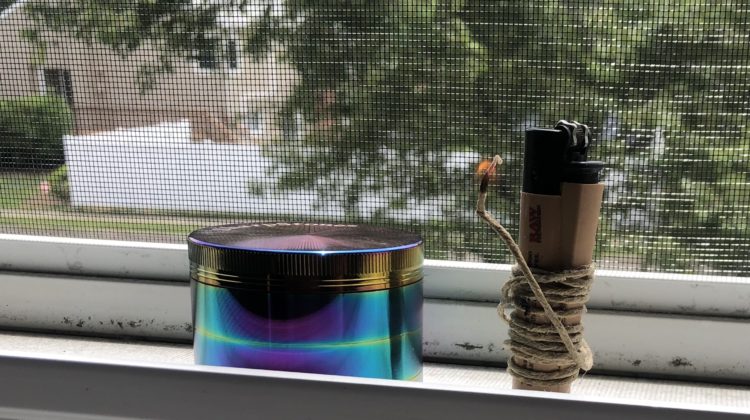
Hemp wick and grinder. Photo by Ryan Kamber.
Hemp wick has been around for millennia, yet today it feels like it’s only used by snobby stoners. Everyone knows the type. Whether they religiously clean their piece; refuse any cannabis that isn’t “high grade;” make fun of their friend’s one-hitter; or all of the above — there is no shortage of these choosey cannabis aficionados. So what draws this specific archetype to hemp wick, and why don’t more people use it?
Hemp wick is a long string of hemp that is coated in beeswax. Its most well-known use today is in candles. However, many cannabis enthusiasts use hemp wick to burn their flower, only using a traditional lighter or match to light the wick, but not the bud itself. Wick users justify this extra step by citing factoids about how using hemp wick is “healthier” and that they’re “getting the most from every bowl.” But is there any validity to those claims?
Worry not, as we were willing to withstand the workload. What we unwrapped widened our worldview. Will we prove wick warriors woefully wrong? Or do these wicks wield wokeness?
We’re done withholding wisdom. Welcome to the wonderful world of wicks.
Hemp Wick History
According to Bee Line Hemp Wick, Humans have used hemp wicks for thousands of years, with its first recorded use in ancient Egypt. Egyptians melted animal fat into a liquid form and used it to coat fibers of hemp, flax, or cotton.
The Romans improved upon the hemp wick to create the modern candle. People then used beeswax instead of animal fat during the Middle Ages, which produced a more pleasant smell than its predecessor, adds Bee Line Hemp Wick.
Hemp then made its way to North America with British voyagers during the colonization of America, according to Weedmaps. In the 17th century, the British monarchy put out a royal decree that required all property owners of Jamestown, as well as settlements in Massachusetts and Delaware, to grow hemp plants for export.
In the mid-1700s, George Washington predicted that the potential profits and usefulness of hemp could exceed that of tobacco. Mount Vernon — Washington’s Estate — explains that Washington was such a big believer in this that he devoted Muddy Hole, one of five farms on his Virginia plantation, to the growth of hemp in an attempt to leave the tobacco industry.
Cannabis’s status rose in the 1800s, as the National Hemp Association reports that the first industrial revolution drastically increased hemp production.
Later, the Mexican Revolution in 1910 drove a wave of immigrants to America who helped introduce cannabis to the U.S. This, combined with the prominence of cannabis among Black jazz musicians in the 1920s, motivated officials like the notoriously racist U.S. Narcotics Commissioner Henry Anslinger to “falsely claim the plant’s exotic nature and taint on white America,” reports Emerald.
In the 1970s, efforts to prohibit cannabis came to fruition with the Controlled Substance Act, which categorized it as a dangerous narcotic without medical use.
A new Generation
The 1960s and 70s were an integral time for the reintroduction of cannabis and hemp into the mainstream. A counterculture made up of baby boomers rejected the conservative ways of their parents. This counterculture would go on to be represented by a group commonly referred to as “hippies.”
While there’s no specific point in time where hemp wick reentered the public view in the mid-20th century, many of these hippies reportedly used it throughout this psychedelic boom.
Now, in 2021, hemp wick is far from common. While many tobacco and cannabis stores do offer hemp wick, most smokers today feel more than fine using a regular butane lighter or match. So are they missing out on anything?
Butane Pain
As previously mentioned, one of the most common methods of igniting cannabis is with a butane lighter. Some disposable butane lighters can burn at temperatures exceeding 3,000 degrees Fahrenheit, according to Sciencing. But outside factors like wind and temperature keep it below that figure.
While temperatures this high can be beneficial when using a lighter to ignite a candle, it’s a different story for cannabis. These high temperatures are proven to burn off a considerable amount of terpenes and cannabinoids before the user is even able to consume the cannabis itself.
Inhalation Toxicology published a study that tested the interaction between cannabinoids and the toxic by products produced by inhaling cannabis. They used a vaporizer and a cannabis cigarette to experiment with different temperatures. IT found that at 446 degrees fahrenheit, the vaporizer yielded both the highest cannabinoids-to-by-product ratio and the most total cannabinoids.
While a strand of hemp wick’s flame burns hotter than 446 degrees, it still boils at a substantially lower temperature than a traditional butane lighter, explains Way of Leaf. This not only gets more out of every little terpene and cannabinoid, but it also makes for a much smoother and more pleasant pull for anyone who uses it.
In addition to burning off valuable cannabinoids and terpenes, butane lighters also come with an innate health risk. For instance, inhaling while using a regular Bic lighter can bring the butane from the torch directly into the lungs.
Dispatch the Match
Those hoping that the more “natural” lighting option comes without health risks will be sorely disappointed. While matches don’t use any butane, they contain materials that are similarly harmful for users to inhale.
For example, matches are a concoction of glue, wood, and other combustible materials. Much like butane, these materials can go directly to the lungs when matches are used to spark up.
Ironically, for all we’ve talked about the health-related dangers of using a butane lighter or match to smoke cannabis, we need those exact things to get the wick going.
What’s the difference? When using a match or torch to light the hemp wick, the portion of the wick that touches the initial flame burns off immediately, leaving the user with pure, raw hemp wick that is chemical-free.
Hemp wick also emits a delightful aroma when burning that contributes to the overall aesthetic of the session. The taste of each rip is improved as well, as the palette is treated to a more pronounced cannabis flavor with a natural and smoky hint to it.
So is Wick the Way?
The subject of hemp wick really comes down to a matter of preference. Someone who only smokes on occasion probably doesn’t need to worry about inhaling butane. This type of smoker likely has low tolerance as well, so the number of terpenes and cannabinoids is pretty trivial to them.
For a seasoned stoner, however, hemp wick is an option worth considering at the very least. Particularly, daily smokers are probably much better off using hemp wick. It might be worth the extra step from a long-term perspective.
Whether it’s for the lungs, the flavor, or the overall experience, hemp wick proves useful for anyone who’s given it a shot.
It’s no wonder why these wise weeders want wick.



Loads of information and love the findings on George Washington and the beginnings of growing hemp!! Who knew? So how many people are using cannibus product for recreation??
You guy’s missed a n in Anslinger’s name.